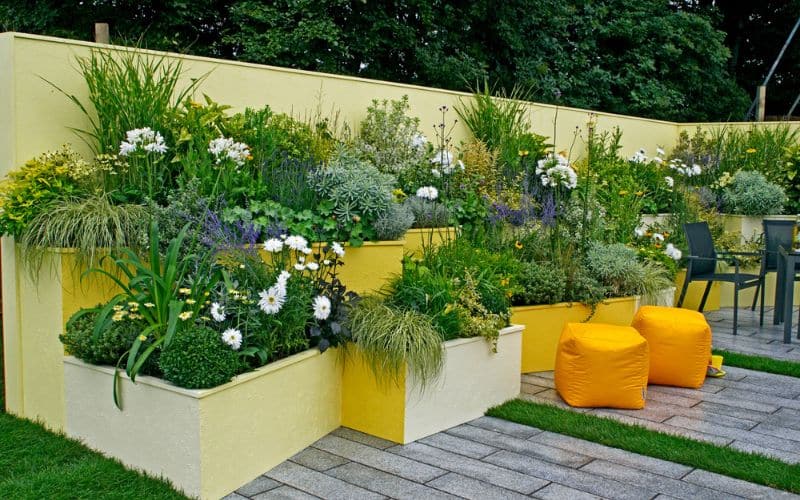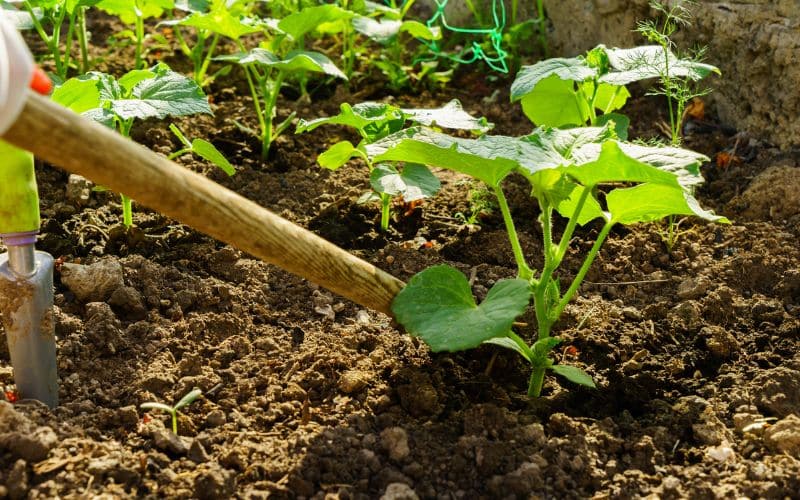
Thinking about starting a garden but your outdoor space is a concrete canvas? Don’t let that hard surface deter you. Raised garden beds on concrete are not just possible; they’re a savvy solution for modern gardening woes. With the right setup, your concrete garden can offer excellent drainage, fewer weeds, and even a head start on the growing season thanks to warmer soil.
You’ll discover how to harness the benefits of concrete for your green space. From avoiding stained surfaces to ensuring proper water drainage, we’ll cover the essentials for a thriving raised bed on a concrete foundation. Stay tuned to transform your concrete jungle into a lush, productive oasis.
What is a Concrete Raised Garden Bed?
Definition of a Concrete Raised Garden Bed
A concrete raised garden bed is a structured planter made from concrete materials used to grow a variety of plants. Unlike traditional garden beds that sit directly on the soil, these beds are elevated off the ground and often rest on concrete or other hard surfaces. They’re designed with an open bottom to enhance drainage and prevent soil compaction, ensuring a fertile environment for plant roots. These garden beds can be made from pre-cast concrete panels or blocks and provide a durable, long-term solution for urban gardening.
Benefits of a Concrete Raised Garden Bed
Optimal Drainage: The raised nature and open-bottom design ensure excess water easily drains away, preventing root rot and fungal diseases.
Soil Temperature Control: Concrete absorbs and retains heat, which can raise soil temperature, speeding up germination and growth in the early season.
- Weed Suppression: Elevated from the surrounding area, these garden beds drastically reduce weed invasion, decreasing maintenance efforts.
- Longevity: Concrete beds are robust and weather-resistant. They withstand the elements much better than wood or metal counterparts.
- Pest Deterrence: Being off the ground, the beds are less accessible to pests such as slugs and rodents.
- Customization: You can tailor the size and shape of your concrete garden bed to fit the available space, making it ideal for small or irregularly-shaped areas.
- Aesthetic Appeal: A well-designed concrete raised bed can add a modern, sleek look to your garden, complementing contemporary landscapes.
Through the practical application of these beds, gardeners have reported increased yields and easier management of their garden spaces. For instance, an urban homeowner converted their barren rooftop into a flourishing vegetable garden using concrete raised beds, experiencing a significant improvement in plant health and productivity due to the controlled soil environment.
How to Build a Concrete Raised Garden Bed
Step 1: Choosing the Location
Sunlight, space, and surface level are key when selecting the perfect spot for your concrete raised garden bed. Begin by assessing which areas receive full sun and which are partially shaded to match the needs of your plants. Ensure the location is on a flat surface to facilitate even water runoff and prevent pooling that might lead to excess moisture.
Step 2: Clearing the Area
Once you’ve chosen a suitable location, clear any debris, rocks, or vegetation. This helps prevent unevenness in the base and ensures that your garden bed has a solid foundation. Remember to remove any objects that might obstruct stability or drainage.
Step 3: Measuring and Marking
After clearing the chosen area, measure and mark the dimensions of your garden bed. Consistency in your measurements ensures your raised bed has the correct proportions. Use stakes and string to outline the area, keeping it as precise as possible to avoid errors in structure size.
Step 4: Excavating the Area
Excavate within your marked boundary to create a level base for the garden bed. The depth will depend on the height of your planned structure but ensuring a level base is crucial for the longevity of the bed. Remove any additional high spots as you go for uniform depth.
Step 5: Preparing the Formwork
Creating formwork involves building a temporary mold that shapes the concrete. Use straight boards that are cut to the desired dimensions of your garden bed. Secure them with screws to maintain their shape during the pouring process. Stability in formwork is critical to achieve the desired shape and robustness of your garden bed.
Step 6: Mixing the Concrete
Follow the manufacturer’s instructions strictly when mixing concrete to get the right consistency. For a 36″ panel, you’ll need approximately 0.363 cubic feet of concrete. Mix thoroughly until all the dry powder is well incorporated to avoid weak spots in your garden bed.
| Panel Size (inches) | Volume (cu ft) |
|---|---|
| 36″ | 0.363 |
Step 7: Pouring the Concrete
Pour the mixed concrete into the formwork, spreading it evenly and tapping the sides to remove air bubbles. Make sure to fill every corner to avoid voids or weak areas. Level the concrete with a straightedge for a smooth surface.
Step 8: Finishing the Surface
Once poured, the concrete’s surface needs to be smoothed and leveled. Use a trowel for a fine finish, ensuring that there are no bumps or dips. A properly finished surface aids drainage and adds to the aesthetic quality of your raised bed.
Step 9: Curing the Concrete
Curing is critical for strength development. Keep the concrete moist and covered, ideally for 7 to 10 days. Maintaining the appropriate moisture level prevents the concrete from drying too quickly, which can lead to cracking or weakening of your garden bed’s structure.
Maintenance Tips for Concrete Raised Garden Beds
Proper maintenance of your concrete raised garden beds can ensure they remain functional and aesthetically pleasing for years to come. Below, you’ll find practical advice to keep your beds in top condition.
Watering and Drainage
Achieving optimal watering and drainage is crucial for the health of your plants and the longevity of the raised beds. Here’s what you need to do:
- Ensure Proper Drainage: Elevate your beds slightly using spacers or small rocks to enhance runoff. This keeps soil aerobic and plants healthy.
- Monitor Watering: Be mindful not to overwater to prevent leakage and staining on the surrounding surfaces. Use a moisture meter if you’re unsure about the soil’s moisture levels.
- Utilize a Bed Liner: While a liner isn’t necessary for all construction types, it can be beneficial in managing moisture if your soil isn’t particularly absorbent.
Weed Control
Weeds can be more than just an eyesore; they can also siphon nutrients away from your plants. Keep these tips in mind to keep weeds at bay:
- Use Mulch: Apply a layer of mulch to suppress weed growth and maintain soil moisture.
- Regular Inspection: Periodically inspect your beds for weeds and remove them promptly, preferably before they seed.
Checking for Cracks
Concrete may develop cracks over time, which can become a serious issue if ignored. Stay on top of this with simple steps:
- Regular Inspections: Check for cracks or signs of wear, particularly after extreme weather conditions.
- Prompt Repairs: Use a concrete patching compound to fill any small cracks immediately to prevent them from expanding.
Cleaning and Sealing
To maintain the appearance and integrity of your garden beds:
- Regular Cleaning: Remove any debris and clean the surface using a pressure washer if discoloration occurs.
- Apply Sealant: Consider sealing the concrete periodically to protect against moisture penetration and weathering. Make sure the sealant is suitable for garden use and will not harm your plants.
Remember, consistent care will help extend the life of your concrete raised garden beds and protect the investment you’ve made into your garden. Implementing the above measures will keep your garden not only thriving but also visually harmonious with your outdoor space.
Plants Suitable for Concrete Raised Garden Beds
Vegetables
When you’re looking to cultivate edibles in your concrete raised garden beds, certain vegetables rise above the rest. Leafy greens, such as spinach and kale, thrive in the well-draining conditions that concrete beds offer. Due to their shallow roots, they’re less likely to suffer from the quick temperature shifts that can occur with concrete.
Additionally, root vegetables like carrots and beets are excellent choices. These resilient crops appreciate the deeper soil layers that raised beds provide, allowing their roots to expand freely. Remember, a depth of at least 12 inches is optimal for healthy growth.
Legumes, including beans and peas, also adapt well to raised beds. They usually require some form of support, such as trellising, to accommodate their climbing nature. This also maximizes the use of vertical space, something that’s particularly useful when you’re working with limited areas.
Here are some top vegetable picks for your garden:
- Spinach
- Kale
- Carrots: Ensure at least 12 inches soil depth
- Beets
- Beans: Require trellising
- Peas: Benefit from vertical space usage
Herbs
Herbs are some of the most rewarding plants you can grow in a concrete raised bed due to their minimal soil depth requirements and frequent use in the kitchen. Basil, thyme, oregano, chives, rosemary, and sage not only provide fresh flavors but also tend to be low-maintenance and drought-resistant, making them ideal for these settings.
Certain herbs, like mint, are known for their vigorous spreading. Planting them in a contained space such as a concrete raised bed can help keep them in check. It’s a smart move that allows you to enjoy their robust flavors without allowing them to overtake your garden.
Consider these herbs for your raised beds:
- Basil
- Thyme
- Oregano
- Chives
- Rosemary
- Sage
- Mint: Plant in a contained space to control growth
Flowers
Flowers in concrete raised beds can transform your space aesthetically while also promoting biodiversity. Marigolds are not only vibrant and cheerful but also act as natural pest deterrents, making them an excellent companion for your vegetables and herbs.
Lavender, with its lovely scent and beautiful purple blooms, is another great option. It’s particularly suited to the well-draining conditions of raised concrete beds and, once established, is quite resilient to drought.
If you’re interested in attracting pollinators, zinnias and sunflowers make for tantalizing choices. They are not only attractive to bees and butterflies but also bring a splash of color to your garden landscape.
Here’s a list of flowers that’ll brighten up your garden beds:
- Marigolds: Deter pests
- Lavender: Requires well-draining soil
Conclusion
Embracing concrete raised garden beds offers you a robust solution for your gardening needs. You’ve learned how to maintain them and the ideal plants that’ll flourish in these conditions. Remember to stick with shallow-rooted veggies and herbs to ensure your garden thrives. Incorporating flowers not only adds a splash of colour but also invites a diverse ecosystem into your space. With these insights you’re well-equipped to create a vibrant and productive garden that stands the test of time. Now’s the time to put your green thumb to work and enjoy the fruits of your labour!
Colin Macmillan is a seasoned entrepreneur and the CEO of Riverwood Landscape, a leading landscaping company based in Canada. He has been at the helm of the company since leaving high school, demonstrating his strong leadership skills and business acumen.
Colin’s expertise lies in various aspects of landscaping, including lawn care, interlocking, sod installation, and commercial maintenance. His hands-on approach and dedication to the craft have been instrumental in building Riverwood Landscape into a reputable brand.
One of his most notable achievements is the creation of a successful landscape franchise that services multiple locations. This accomplishment underscores his strategic thinking and ability to scale operations effectively.
Colin has also had the privilege of working with Guelph Hospital for landscaping and maintenance, a testament to the trust and reliability that his company has earned over the years.
His professional mission is to offer the best services and experiences for customers, a goal that he tirelessly pursues. Colin’s commitment to excellence and customer satisfaction continues to drive the growth and success of Riverwood Landscape.










